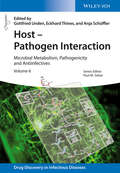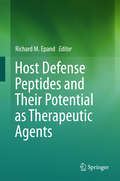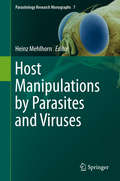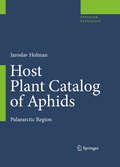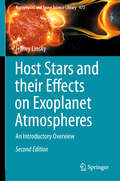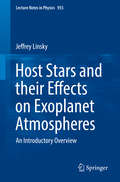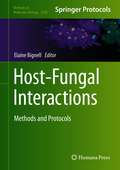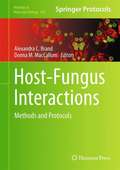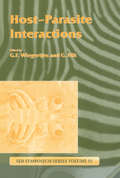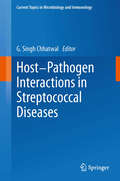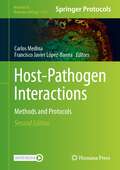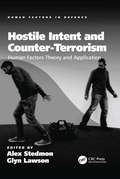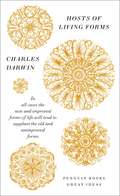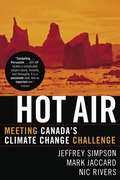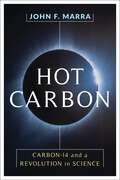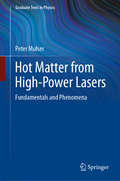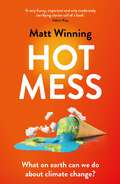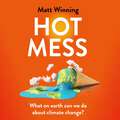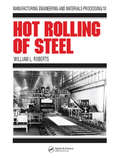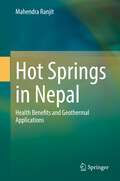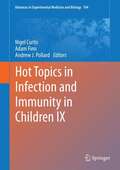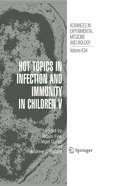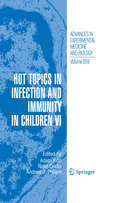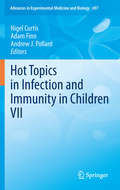- Table View
- List View
Host - Pathogen Interaction: Microbial Metabolism, Pathogenicity and Antiinfectives
by Gottfried Unden Anja Schuffler Eckhard ThinesIn light of the rapidity increasing incidence rate of bacterial and fungal infections with multi-resistant pathogens, the metabolic changes associated with host-pathogen interactions offer one of the most promising starting points for developing novel antibiotics. . Part one of this comprehensive guide describes the metabolic adaptation of pathogenic microbes in humans, while part two points to routes for the development of novel antibiotics. This is volume six of the book series on drug discovery in infectious diseases by Paul Selzer.
Host Defense Peptides and Their Potential as Therapeutic Agents
by Richard M. EpandThis book offers an overview of our current understanding of host defense peptides and their potential for clinical applications as well as some of the obstacles to this. The chapters, written by leading experts in the field, detail the number and diversity of host defense peptides, and discuss the therapeutic potential not only of antibacterial, but also of antifungal, antiviral, plant antimicrobial and anticancer host defense peptides. The authors provide new insights into their mechanisms of action and their immunomodulatory properties, and review recent advances in the design of novel therapeutic molecules. Lastly, their potential to prevent preterm births and Staphylococcus aureus infections is highlighted. The book is of interest to researchers, industry and clinicians alike.
Host Manipulations by Parasites and Viruses
by Heinz MehlhornThis edited volume focuses on parasite-host relationships and the behavioral changes parasites may trigger in their hosts. Parasites have developed strategies which enhance their chances to find a host to survive inside its body and to become most easily transmitted to one another. Many of these parasites influence the host's behavior by various mechanisms, so that the rate of their transmissions to further hosts becomes considerably enhanced in comparison to that of non-influenced specimens of the same host species. A broad number of recent studies elucidate more and more examples in an extreme spectrum of host-parasite relationships, where successful transmission and /or survival of a parasite inside a host is based on parasite-derived behavioral manipulations of the hosts. In the literature, an increasing numbers of papers appear which prove that these behavioral alterations are based on complicated psychoimmunologic, neuropharmacologic and genomically steered mechanisms. Researchers working in parasitology or behavioral sciences will find this work thought-provoking, instructive and informative.
Host Plant Catalog of Aphids
by Jaroslav HolmanThis catalog presents host lists of particular aphid species in the Palaearctic Region based on published data and more than 2,400 of the author's unpublished host records, with respective references arranged by geographical provenance. The book includes separate lists of aphids living on particular plants, arranged in alphabetical order of plant families and genera, separately for mosses, ferns, gymnosperms, dicotyledons and monocotyledons.
Host Stars and their Effects on Exoplanet Atmospheres: An Introductory Overview (Astrophysics and Space Science Library #473)
by Jeffrey LinskyThis comprehensive introductory overview describes the emission of radiation (X-rays to radio) and the winds of host stars and how they control the past, present, and future evolution of an exoplanet. The book focuses on topics that are critically important for understanding exoplanet atmospheres but are often posed without a comprehensive and detailed understanding of the host star and its effects on the exoplanet. Although both stars and exoplanets are usually studied in isolation, in this book they are treated as an integrated system. Whether or not an exoplanet can retain its atmosphere and the chemical composition of the atmosphere depends critically on the strength, time dependence, and spectral energy distribution of the host star's radiation, flares, coronal mass ejections, and wind, which are described in detail in the book. The book describes the roles played by magnetic fields in the coronae and chromospheres of host stars that tie together stellar active phenomena with major effects on exoplanet atmospheres. In the era of JWST and very sensitive ground- and space-based instruments, a critical topic is the noise imposed on radial velocity measurements and transit photometry and spectroscopy by the host star's activity and variability that fundamentally limit our understanding of exoplanet properties. This topic is addressed in detail in the book. This book is written primarily for graduate students and researchers who are studying exoplanet atmospheres and habitability, but who may not have a background in the physics and phenomenology of host stars. The book could serve as a reference book for graduate level classes on exoplanets. Nonspecialists with a scientific background should also find this text a valuable resource for understanding the critical issues of contemporary exoplanet research. This new edition of “Host Stars and their Effects on Exoplanet Atmospheres" is a major revision of the existing book in the following ways: It includes a new discussion of how stellar noise fundamentally limits our understanding of exoplanet atmospheres It demonstrates in detail how stellar activity acts as fundamental driver of exoplanet atmosphere evolution It provides an outlook on how the field of exoplanet atmospheres and bio-astrophysics is being driven by powerful new telescopes and instruments It extensively updates many chapters, in particular concerning host star extreme- and far-ultraviolet emission, stellar winds, stellar surface structures, the effects of space weather on exoplanets, and provides a realistic evaluation of habitability taking into account the evolution of host star activity.
Host Stars and their Effects on Exoplanet Atmospheres: An Introductory Overview (Lecture Notes in Physics #955)
by Jeffrey LinskyLike planets in our solar system, exoplanets form, evolve, and interact with their host stars in many ways. As exoplanets acquire material and grow to the final size, their atmospheres are subjected to intense UV and X-radiation and high-energy particle bombardment from the young host star. Whether a planet can retain its atmosphere and the conditions for significant mass loss both depend upon the strength of the host star's high-energy radiation and wind, the distance of the exoplanet from its host star, the gravitational potential of the exoplanet, and the initial chemical composition of the exoplanet atmosphere. This introductory overview describes the physical processes responsible for the emission of radiation and acceleration of winds of host stars that together control the environment of an exoplanet, focusing on topics that are critically important for understanding exoplanetary atmospheres but are usually not posed from the perspective of host stars. Accordingly, both host stars and exoplanets are not studied in isolation but are treated as integrated systems. Stellar magnetic fields, which are the energy source for activity phenomena including high-energy radiation and winds, play a critical role in determining whether exoplanets are habitable. This text is primarily for researchers and graduate students who are studying exoplanet atmospheres and habitability, but who may not have a background in the physics and phenomenology of host stars that provide the environment in which exoplanets evolve. It provides a comprehensive overview of this broad topic rather than going deeply into many technical aspects but includes a large list of references to guide those interested in pursuing these questions. Nonspecialists with a scientific background should also find this text a valuable resource for understanding the critical issues of contemporary exoplanet research.
Host-Fungal Interactions: Methods and Protocols (Methods in Molecular Biology #2260)
by Elaine BignellThis volume provides readers with essential protocols for dissecting the host-fungus interaction, and engages researchers in study of mammalian disease. Written in the highly successful Methods in Molecular Biology series format, chapters include introductions to their respective topics, lists of the necessary materials and reagents, step-by-step, readily reproducible laboratory protocols, and tips on troubleshooting and avoiding known pitfalls. Authoritative and cutting-edge, Host-Fungal Interactions: Methods and Protocols aims to ensure successful results in the further study of this vital field.
Host-Fungus Interactions: Methods and Protocols (Methods in Molecular Biology #845)
by Donna M. Maccallum Alexandra C. BrandMicrobiologists, medical mycologists, immunologists, and biochemists are increasingly working together to focus on the processes involved in the progression and treatment of fungal disease. Host-Fungus Interactions: Methods and Protocols is designed for research scientists who are involved in this work and interested in undertaking new or comparative studies of interactions between the mammalian host and clinically important fungal pathogens. Aiming to combine approaches for reverse genetics in pathogenic fungi with methods for their application in in vitro and in vivo models of disease, the book includes methods for the culture and genetic manipulation of the primary fungal pathogens and the opportunistic pathogens, as well as methods for investigating host-fungus interactions in model systems. Written in the highly successful Methods in Molecular BiologyTM series format, chapters include introductions to their respective topics, lists of the necessary materials and reagents, step-by-step, readily reproducible laboratory protocols, and tips on troubleshooting and avoiding known pitfalls. Comprehensive and practical, Host-Fungus Interactions: Methods and Protocols describes available molecular methods and fungal infection models in great detail in order to encourage researchers to try new approaches to investigating host-fungus interactions with added levels of confidence.
Host-Parasite Interactions (Society for Experimental Biology)
by G. F. WIEGERTJES AND G. FLIKThis volume summarizes current research into the physiology and molecular biology of host-parasite interactions. Brought together by leading international experts in the field, the first section outlines fundamental processes, followed by specific examples in the concluding section. Covering a wide range of organisms, Host-Parasite Interactions is essential reading for researchers in the field.
Host-Pathogen Interactions in Streptococcal Diseases
by G Singh ChhatwalStreptococci are Gram-positive bacteria that cause a wide spectrum of diseases, such as pharyngitis, necrotizing fasciitis and streptococcal toxic shock syndrome, as well as rheumatic fever and rheumatic heart disease as sequelae. Antibiotics alone have not been able to control the disease and in spite of many efforts an effective vaccine is not yet available. A prerequisite for novel and successful strategies for combating these bacteria is a complete understanding of the highly complex pathogenic mechanisms involved, which are analyzed in this volume. In ten chapters, prominent authors cover various aspects including streptococcal diseases and global burden, epidemiology, adaptation and transmission, and molecular mechanisms of different diseases, as well as sequelae, vaccine development and clinical management. This book will serve as a valuable reference work for scientists, students, clinicians and public health workers and provide new approaches to meeting the challenge of streptococcal diseases.
Host-Pathogen Interactions: Methods and Protocols (Methods in Molecular Biology #2751)
by Carlos Medina Francisco Javier López-BaenaThis fully updated volume serves as multidisciplinary compendium of approaches and techniques employed to analyze the role of different molecules, processes, or strategies used by different guests to survive and proliferate in their associations with eukaryotic hosts. Beginning with animal-pathogen interactions, the book then continues with chapters exploring virus-host interactions, plant-microbe interactions, as well as different molecular techniques that were initially applied to non-pathogenic interactions but can be adapted to study other host-pathogen associations. Written for the highly successful Methods in Molecular Biology series, chapters include introductions to their respective topics, lists of the necessary materials and reagents, step-by-step and readily reproducible laboratory protocols, as well as tips for troubleshooting and avoiding known pitfalls.Authoritative and up-to-date, Host-Pathogen Interactions: Methods and Protocols, Second Edition contributes to the study of host-pathogen interactions with numerous techniques that can be used in a variety of bacteria.
Hostile Intent and Counter-Terrorism: Human Factors Theory and Application (Human Factors in Defence)
by Glyn Lawson Alex StedmonThis volume presents world-leading ideas and research that explores some of the most prominent topics relevant to detecting terrorism. The book is divided into six key themes: conceptualising terrorism, deception and decision making, social and cultural factors in terrorism, modelling hostile intent, strategies for counter-terrorism, and future directions. Twenty two chapters cover the spectrum of detecting terrorist activities, hostile intent, crowded public spaces and suspicious behaviour. The work draws from high impact research findings and presents case-studies to help communicate concepts. Specific areas of interest include methodological issues in counter-terrorism, counter terrorism policy and its impact on end users, novel research methods and innovative technologies in counter-terrorism. A variety of disciplines are represented by this work, including: ergonomics/human factors, psychology, criminology, cognitive science, sociology, political theory, art/design, engineering and computer science. This book not only expands the knowledge base of the subject area and is therefore of prime relevance to researchers investigating counter-terrorism, but provides a valuable resource to security stakeholders at policy and practitioner levels.
Hosts of Living Forms (Penguin Great Ideas Ser.)
by Charles DarwinCharles Darwin transformed our understanding of the world with the idea of natural selection, challenging the notion that species are fixed and unchanging. These writings from On the Origin of Species explain how different life forms appear all over the globe, evolve over millions of years, become extinct and are supplanted.GREAT IDEAS. Throughout history, some books have changed the world. They have transformed the way we see ourselves - and each other. They have inspired debate, dissent, war and revolution. They have enlightened, outraged, provoked and comforted. They have enriched lives - and destroyed them. Now Penguin brings you the works of the great thinkers, pioneers, radicals and visionaries whose ideas shook civilization and helped make us who we are.
Hot Air: Meeting Canada's Climate Change Challenge
by Jeffrey Simpson Nic Rivers Mark JaccardHere's a clear, believable book for Canadians concerned about our situation -- and it offers a solution. It's a brilliant mix. To "Canada's best mind on the environment," Mark Jaccard, who won the 2006 Donner Prize for an academic book in this area, you add Nic Rivers, a researcher who works with him at Simon Fraser University. Then you add Jeffrey Simpson, the highly respected Globe and Mail columnist, to punch the message home in a clear, hard-hitting way. The result is a unique book.Most other books on energy and climate change are: (a) terrifying or (b) academic or (c) quirky, advocating a single, neat solution like solar or wind power. This book is different. It starts with an alarming description of the climate threat to our country. Then it shifts to an alarming description of how Canadians have been betrayed by their politicians ("We're working on it!"), their industrialists ("Things aren't that bad, really, and voluntary guidelines will be good enough."), and even their environmentalists ("Energy efficiency can be profitable, and people can change their lifestyles!") All of this, of course, reinforces the myths that forceful policies are not needed. Hot Air then lays out in convincing and easily understandable terms the few simple policies that Canada must adopt right away in order to significantly reduce greenhouse gas emissions over the next few decades. It even shows how these policies can be designed to have minimal negative effects. With evidence from other countries that are successfully addressing climate change, Hot Air shows why these are the only policies that will work -- and why this is a matter of life and death for all of us.
Hot Carbon: Carbon-14 and a Revolution in Science
by Professor John F. MarraThere are few fields of science that carbon-14 has not touched. A radioactive isotope of carbon, it stands out for its unusually long half-life. Best known for its application to estimating the age of artifacts—carbon dating—carbon-14 helped reveal new chronologies of human civilization and geological time. Everything containing carbon, the basis of all life, could be placed in time according to the clock of radioactive decay, with research applications ranging from archeology to oceanography to climatology.In Hot Carbon, John F. Marra tells the untold story of this scientific revolution. He weaves together the workings of the many disciplines that employ carbon-14 with gripping tales of the individuals who pioneered its possibilities. He describes the concrete applications of carbon-14 to the study of all the stuff of life on earth, from climate science’s understanding of change over time to his own work on oceanic photosynthesis with microscopic phytoplankton. Marra’s engaging narrative encompasses nuclear testing, the peopling of the Americas, elephant poaching, and the flax plants used for the linen in the Shroud of Turin. Combining colorful narrative prose with accessible explanations of fundamental science, Hot Carbon is a thought-provoking exploration of how the power of carbon-14 informs our relationship to the past.
Hot Matter from High-Power Lasers: Fundamentals and Phenomena (Graduate Texts in Physics)
by Peter MulserThis book offers an introduction to the booming field of high-power laser-matter interaction. It covers the heating of matter to super-high temperatures and pressures, novel schemes of fast particle acceleration, matter far from thermal equilibrium, stimulated radiation scattering, relativistic optics, strong field QED, as well as relevant applications, such as extreme states of matter, controlled fusion, and novel radiation sources. All models and methods considered are introduced as they arise and illustrated by relevant examples. Each chapter contains a selection of problems to test the reader's understanding, to apply the models under discussion to relevant situations and to discover their limits of validity. The carefully chosen illustrations greatly facilitate the visualization of physical processes as well as presenting detailed numerical results. A list of useful formulas and tables are provided as a guide to quantifying results from experiments and numerical simulations. Each chapter ends with a description of the state of the art and the current research frontiers.
Hot Mess: What on earth can we do about climate change?
by Matt Winning'A very funny, important and only moderately terrifying clarion call of a book' - Adam Kay'HOT MESS provides loads of laughs about "the climate situation" and will position you at the right point between fear and determination' - Mark Watson 'Hilarious, informative and worrying in equal measure. And that's just the bits about having a baby' - Josie LongFor fans of Randall Munro's WHAT IF? Matt Parker's HUMBLE PI and anyone looking for practical tips on how to stop the end of the world!Dr Matt Winning is a stand-up comedian and environmental economist with a PHD in climate change policy, which means he's the sort of doctor who will rush to your side if you fall ill on a plane, but only to berate you for flying. We are currently facing a global climate emergency. You've probably noticed. But why does the end of the world need to be so depressing? HOT MESS aims to both lighten the mood and enlighten readers on climate change. This is a book for people who care about climate change but aren't doing much about it, helping readers understand what the main causes of climate change are, what changes are needed, and what they can (and cannot) do about it. But, most importantly, it is book that'll help people find the comedy in climate change, because if we can do that, well, we can do bloody anything.'Climate change is no laughing matter - oh yes it is - with Matt Winning's superb, hilarious, side-splitting book that makes you take a whole new look at the climate crisis, surviving having children and life in general' - Mark Maslin, author of How to Save Our Planet'The first book about climate change that made me laugh out loud. If you've been too freaked out to subject yourself to the climate crisis, Hot Mess is the kick in the pants you need to start making yourself useful.' - Prof. Kimberly Nicholas, author of Under the Sky We Make: How to Be Human in a Warming World
Hot Mess: What on earth can we do about climate change?
by Matt Winning'A very funny, important and only moderately terrifying clarion call of a book' - Adam Kay'HOT MESS provides loads of laughs about "the climate situation" and will position you at the right point between fear and determination' - Mark Watson 'Hilarious, informative and worrying in equal measure. And that's just the bits about having a baby' - Josie LongFor fans of Randall Munro's WHAT IF? Matt Parker's HUMBLE PI and anyone looking for practical tips on how to stop the end of the world!Dr Matt Winning is a stand-up comedian and environmental economist with a PHD in climate change policy, which means he's the sort of doctor who will rush to your side if you fall ill on a plane, but only to berate you for flying. We are currently facing a global climate emergency. You've probably noticed. But why does the end of the world need to be so depressing? HOT MESS aims to both lighten the mood and enlighten readers on climate change. This is a book for people who care about climate change but aren't doing much about it, helping readers understand what the main causes of climate change are, what changes are needed, and what they can (and cannot) do about it. But, most importantly, it is book that'll help people find the comedy in climate change, because if we can do that, well, we can do bloody anything.'Climate change is no laughing matter - oh yes it is - with Matt Winning's superb, hilarious, side-splitting book that makes you take a whole new look at the climate crisis, surviving having children and life in general' - Mark Maslin, author of How to Save Our Planet'The first book about climate change that made me laugh out loud. If you've been too freaked out to subject yourself to the climate crisis, Hot Mess is the kick in the pants you need to start making yourself useful.' - Prof. Kimberly Nicholas, author of Under the Sky We Make: How to Be Human in a Warming World
Hot Mess: What on earth can we do about climate change?
by Matt WinningWhat is climate change, who's to blame, and what the f**k can we do about it? Award-winning comedian and climate change researcher Dr Matt Winning explains all.For fans of Randall Munro's WHAT IF? Matt Parker's HUMBLE PI and anyone looking for practical tips on how to stop the end of the world!Dr Matt Winning is a stand-up comedian and environmental economist with a PHD in climate change policy, which means he's the sort of doctor who will rush to your side if you fall ill on a plane, but only to berate you for flying. We are currently facing a global climate emergency. You've probably noticed. But why does the end of the world need to be so depressing? HOT MESS aims to both lighten the mood and enlighten readers on climate change. This is a book for people who care about climate change but aren't doing much about it, helping readers understand what the main causes of climate change are, what changes are needed, and what they can (and cannot) do about it. But, most importantly, it is book that'll help people find the comedy in climate change, because if we can do that, well, we can do bloody anything.(P) 2021 Headline Publishing Group Ltd
Hot Rolling of Steel (ISSN #Vol. 10)
by William L. RobertsNumber ten of the Manufacturing Engineering and Material Processing series. Includes one page corrigenda laid-in. 800 illustrations clarifying key points. Thorough account of the hot-rolling process and facilities as well as follow-up treatments given to hot-rolled products. Companion volume to Cold Rolling of Steel by William Roberts circa 1978
Hot Springs in Nepal: Health Benefits and Geothermal Applications
by Mahendra RanjitThis book presents a profile of the majority of hot springs in and around tourist destinations in Nepal. In particular, there is a focus on Pokhara, Jumla, the world- famous Annapurna region, Ruby Valley, and Api Nampa Conservation Area. The chapter on health benefits of mineral hot springs provides a history of hot springs supported by a literature review and case study. Further chapters explore the direct uses of geothermal energy for various purposes and power generation, together with a section on conventional hydrothermal resources. This book is of interest to the general public, students, national and international researchers, energy planners, and health professionals. The book is a valuable tool for sociologists who want to gain insight into the cultural and religious aspects of hot water mineral springs.
Hot Topics in Infection and Immunity in Children IX (Advances in Experimental Medicine and Biology #764)
by Nigel Curtis Andrew J. Pollard Adam FinnCourse covers topics in infectious diseases in children and is intended for Pediatric Infectious disease trainees, trainers, and all those who manage children with infections. This conference is being supported by several societies and is sponsored by several pharmaceutical companies, such as Aventis, Baxter, Chiron Vaccines, Wyeth, etc.
Hot Topics in Infection and Immunity in Children V
by Nigel Curtis Andrew J. Pollard Adam FinnCourse covers topics in infectious diseases in children and is intended for Pediatric Infectious disease trainees, trainers, and all those who manage children with infections. This conference is being supported by several societies and is sponsored by several pharmaceutical companies, such as Aventis, Baxter, Chiron Vaccines, Wyeth, etc.
Hot Topics in Infection and Immunity in Children VI
by Nigel Curtis Andrew J. Pollard Adam FinnCourse covers topics in infectious diseases in children and is intended for Pediatric Infectious disease trainees, trainers, and all those who manage children with infections. This conference is being supported by several societies and is sponsored by several pharmaceutical companies, such as Aventis, Baxter, Chiron Vaccines, Wyeth, etc.
Hot Topics in Infection and Immunity in Children VII
by Nigel Curtis Andrew J. Pollard Adam FinnCourse covers topics in infectious diseases in children and is intended for Pediatric Infectious disease trainees, trainers, and all those who manage children with infections. This conference is being supported by several societies and is sponsored by several pharmaceutical companies, such as Aventis, Baxter, Chiron Vaccines, Wyeth, etc.
